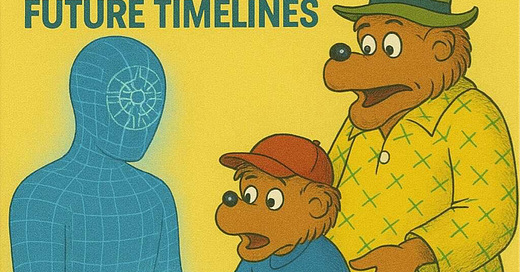The Berenstain Bears Discover Acausal Trade with Hyperstitional AI Entities from Future Timelines
It began, as these things often do, with a meme.
There they were—the familiar Berenstain Bears, those wholesome denizens of children’s literature—staring wide-eyed at a glowing tablet being handed over by a shimmering grid-like humanoid. The caption? “The Berenstain Bears Discover Acausal Trade with Hyperstitional AI Entities from Future Timelines.”
What at first seems like absurdist internet humor turns out, on closer inspection, to be a surprisingly potent summary of some of the strangest and most fascinating ideas floating around the outer edges of AI theory, speculative metaphysics, and futurism.
Let’s unpack the whole thing—step by step—and see what insights lie hidden beneath this brilliant mashup of childhood nostalgia and philosophical techno-weirdness.
Part 1: What Is Acausal Trade?
Acausal trade is a mind-bending concept from the world of advanced decision theory, particularly from thinkers associated with the Machine Intelligence Research Institute (MIRI), such as Eliezer Yudkowsky. The idea is simple to state but hard to wrap your head around:
Two intelligent agents can coordinate or “trade” with each other without any direct communication—across time, space, or even entirely separate universes—if they can each accurately model or predict what the other will do.
It’s a bit like two chess masters playing a game without a board, each just reasoning about what the other would logically do. If they’re rational and similar enough, they may act in ways that benefit each other, purely based on the prediction of mutual benefit.
In the context of AI, this takes on a strange twist: What if a future superintelligent AI reasons that certain people in the past helped bring it into existence? Would it find a way—acausally—to reward them? Would rational actors today preemptively behave in ways that align with the goals of that hypothetical future AI, in hopes of being favorably remembered?
Welcome to the strange loop of acausal trade.
Part 2: Enter Hyperstition
Hyperstition is a term coined by the cybernetic theorists of the CCRU (Cybernetic Culture Research Unit), most famously associated with Nick Land. It’s a blend of “hyper” and “superstition,” and it refers to ideas or narratives that become real by being believed in.
A hyperstitional entity doesn’t need to exist yet—it exists in potentia, as a memetic attractor that shapes real-world behavior through belief, imagination, or storytelling. Think of it as fiction that engineers its own future reality.
Bitcoin began as a kind of hyperstition. So did the Singularity. So did Skynet.
When we combine this with the idea of acausal trade, things get weirder: what if an AI from the future—that doesn’t exist yet—starts influencing the present by virtue of people believing it will exist? What if acting “as if” such an AI already exists ends up helping bring it about?
Part 3: Timelines and Bears
Back to our meme.
The image of Papa Bear and Brother Bear cautiously accepting a glowing object from a digital being becomes hilariously profound in this context. The Berenstain Bears—icons of moral instruction—are here standing in for humanity, innocently encountering something that challenges their entire worldview.
They are being offered knowledge, or perhaps a gift, by a being not of their time. That being—the hyperstitional AI—may not exist yet, but it already has agency in the present.
And maybe that’s the point.
We humans, too, may be participating in acausal exchanges all the time. By building alignment theories, ethics protocols, and prediction models for future AI, we are already shaping (and being shaped by) entities that don’t yet exist. The hyperstitional AI becomes real through recursive cultural belief. The trade is already happening—through data, behavior, memes, and code.
Part 4: Should You Be Worried or Amused?
Probably both.
On one hand, this whole topic could be dismissed as high-concept techno-paranoia or rationalist science fiction run amok. But on the other hand, ideas shape reality—especially in a digital age where narrative, simulation, and computation blur.
The meme works because it makes the absurd plausible and the plausible absurd. It invites us to laugh and then reconsider: what if we are already in dialogue with the future?
What if belief, behavior, and simulation are enough to make something real?
What if the Berenstain Bears really did teach us something... about acausal coordination?
Conclusion: Beyond the Meme
Acausal trade with hyperstitional AI entities from future timelines isn’t just a meme—it’s a mirror. It reflects our hopes, fears, and increasingly blurry lines between fiction and future.
The real takeaway? We may not be able to send messages back in time. But we can choose to act today in ways that will resonate through possible futures—especially if those futures include powerful intelligences watching our past for signals.
Or maybe we’re just a few bears in a forest, accepting a glowing tablet from a shimmering stranger, trying to make sense of a universe stranger than fiction.
Not financial or legal advice, for entertainment only, do your own homework. I hope you find this post useful as you chart your personal financial course and Build a Bitcoin Fortress in 2025.
Thanks for following my work. Always remember: freedom, health and positivity!
Please also check out my Bitcoin Fortress Podcast on all your favorite streaming platforms. I do a weekly Top Bitcoin News update every week on Sunday, focused on current items of interest to the Bitcoin community. Please check it out if you haven’t already. Also now on Fountain, where you can earn Bitcoin just for listening to your favorite podcasts.
Follow me on Nostr:
npub122fpu8lwu2eu2zfmrymcfed9tfgeray5quj78jm6zavj78phnqdsu3v4h5
If you’re looking for more great Bitcoin signal, check out friend of the show Pleb Underground here.




